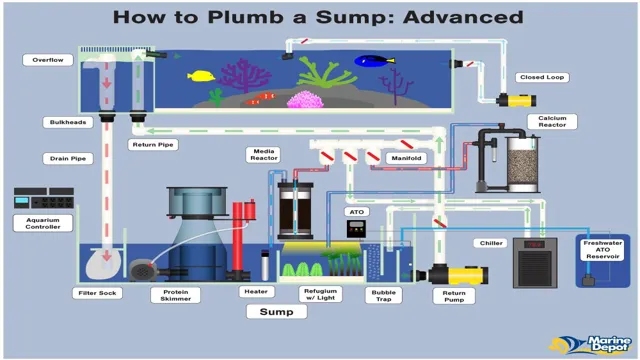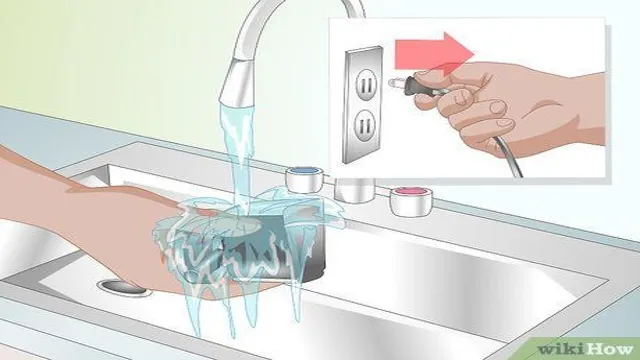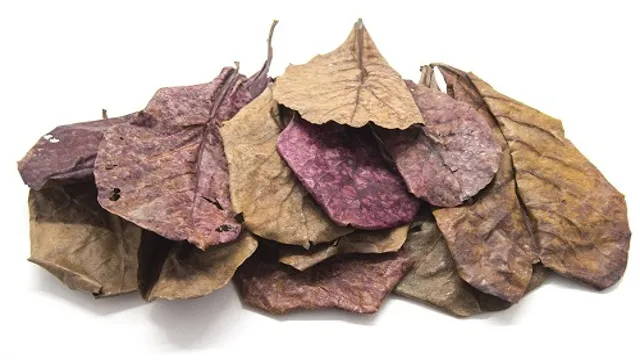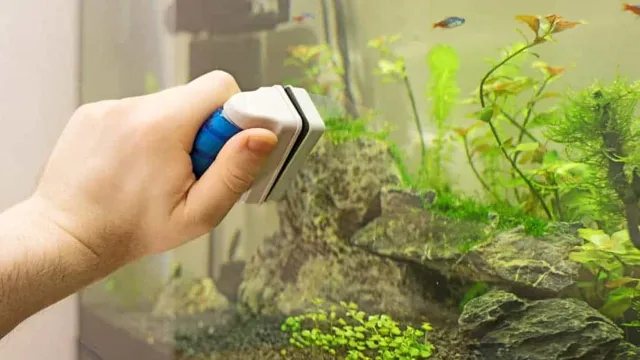Have you ever looked into your aquarium and noticed a green or brown film coating the sides and plants? That, my friend, is algae. While a small amount of algae can be beneficial for your aquarium, an overgrowth can be harmful to your aquatic pets. Not only can it clog filters, but it can also cause oxygen levels to deplete, leading to stress and illness for your fish.
So, what can you do to get rid of it? Don’t worry, we’re here to help. In this blog post, we’ll cover various methods for removing and preventing algae growth in your aquarium. Say goodbye to unsightly algae and hello to a sparkling clean tank.
Identify the Type of Algae
One of the most common problems that aquarium owners face is algae growth. However, the first step to getting rid of it is to identify the type of algae present in the aquarium. This is because different types of algae require varying types of treatment.
Some of the common types include green algae, red algae, and brown algae. Green algae are the most common and usually grow on the surface of the water or on aquarium surfaces. They can be treated by reducing the amount of light or adding algae-eating fish.
Red algae, on the other hand, are more difficult to remove and require chemical treatments. Brown algae are common in new aquariums and can be scraped off with a brush or vacuumed out. Knowing the type of algae present can help you choose the right treatment and prevent it from growing back.
By carrying out regular maintenance, including water changes and monitoring the lighting, you can keep your aquarium free of algae and maintain a healthy environment for your fish.
Green Algae
Green Algae Green algae are a diverse group of photosynthetic organisms that can be found in freshwater and marine ecosystems. They come in a variety of shapes and sizes, ranging from simple unicellular forms to complex multicellular forms that resemble plants. One way to identify different types of green algae is to look at their cell structure.
Some types of green algae have two flagella, which are tiny hair-like structures that allow them to move through water. Other types have a single flagellum, while some have no flagella at all. Another distinguishing feature of green algae is their chloroplasts, which contain chlorophyll and other pigments that help them convert sunlight into energy through photosynthesis.
Overall, there are thousands of different species of green algae, each with their own unique adaptations and characteristics. By understanding more about the different types of green algae, we can gain insights into the complexities of aquatic ecosystems and the role that these organisms play in them.
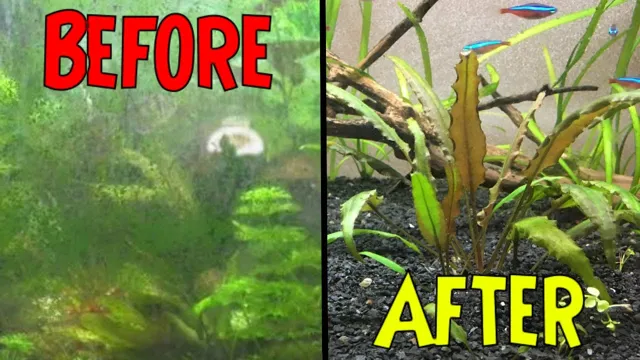
Brown Algae
If you have ever seen slimy, green or brown growth on rocks or in bodies of water, you might have witnessed brown algae. Brown algae grows in marine environments and can have various shapes and sizes. Some brown algae can be leafy, while others have a more feathery texture.
This type of algae is most commonly found in colder waters and can grow in depths of up to 200 feet. One unique characteristic of brown algae is their ability to form gas-filled bladders to help them float towards the surface to collect sunlight. If you suspect that you have brown algae in your pond or aquarium, identifying the specific type of algae is important in determining the best control methods.
Some types of brown algae are beneficial and can provide critical habitat for other organisms in the ecosystem, while others can be harmful and need to be removed.
Red Algae
Red algae are a diverse group of marine algae that are easily recognizable due to their vivid red coloration. There are over 6,000 species of red algae, varying in shape, size, and habitat. One of the easiest ways to identify the type of red algae present is by examining its morphology.
The morphology of red algae can range from unicellular to multicellular, and their pigments responsible for their red coloration are called phycobilins. The presence or absence of specific structures like reproductive organs, cell walls, and thalli help botanists classify red algae into various taxonomic groups. Additionally, the ecological distribution of red algae can vary widely, from shallow, inter-tidal zones to the deep sea.
Some species of red algae are commercially important, as they are used as a source of food, carrageenan, and agar. Understanding the characteristics of red algae is vital to ecological research and the extraction of various products.
Blue-Green Algae
Blue-green algae, also known as cyanobacteria, are classified as photosynthetic bacteria that can be found in both freshwater and marine environments. These microorganisms are often difficult to identify as they can take on different shapes and colors depending on the environmental conditions they are in. However, one prominent characteristic of blue-green algae is their ability to produce toxins that can harm humans and aquatic life.
If you suspect the presence of blue-green algae in a body of water, it is essential to avoid contact with the water and to keep pets away, as they can be affected by the toxins as well. To properly identify the type of algae, it is recommended to consult a professional or send a sample to a laboratory for testing. With proper identification, steps can be taken to manage and control the growth of blue-green algae and protect both human health and the environment.
Causes of Algae Growth
Algae growth in aquariums can be caused by a variety of factors. One of the primary reasons is an excess amount of nutrients in the water, often caused by overfeeding the fish or not cleaning the tank regularly. Additionally, if the aquarium is placed in direct sunlight or has too much lighting, it can encourage algae growth. (See Also: How to Fix a Broken Aquarium Pump – Simple and Quick Solutions)
Poor water circulation can also contribute to the problem as it leads to stagnant water that provides a breeding ground for algae. To get rid of algae in the aquarium, reduce the amount of food given to the fish, and perform regular water changes. Try to keep the aquarium away from direct sunlight and limit the amount of lighting.
Adding a filter to the tank can help improve water circulation and reduce stagnant water. Lastly, consider adding live plants to the aquarium as they compete with the algae for nutrients and can help keep it under control. By taking these steps, you can successfully remove and prevent algae from overtaking your aquarium.
Overfeeding and Overstocking
When it comes to the causes of algae growth, overfeeding and overstocking are two of the biggest culprits. Overfeeding fish is a common mistake that many new aquarium owners make. When too much food is given, the uneaten remains will sink to the bottom and decompose, leading to an increase in nutrients that fuel algae growth.
Overstocking, on the other hand, occurs when there are too many fish in the aquarium for the size of the tank. This can lead to increased waste and uneaten food, adding more nutrients to the water and making it easier for algae to flourish. To combat these issues, it’s important to feed your fish the proper amount and not overcrowd your tank.
Regular water changes and proper filtration can also help keep nutrient levels in check and prevent algae from taking over. By being mindful of the amount of food and fish in your aquarium, you can help keep your aquatic environment healthy and free of unwanted algae.
Low Water Flow and Poor Filtration
If your pool is experiencing low water flow and poor filtration, it may be a sign of algae growth. Algae can quickly take over a pool if the conditions are right, and low water flow and poor filtration create the perfect environment for it to thrive. Algae can grow rapidly in warm, stagnant water, which is why it often becomes a problem during the summer months.
Lack of proper circulation and filtration allows algae to stick to surfaces and form slimy, green or brown patches, making your pool look and smell unpleasant. The key to preventing algae growth is to maintain good water flow and filtration, keep the appropriate chemical levels, and clean the pool regularly. If you notice signs of algae growth, address them immediately to avoid larger problems down the road.
With a little bit of effort and diligence, you can enjoy a sparkling, algae-free pool all summer long.
Excess Light
Excess Light as a Cause of Algae Growth Algae growth can be a pesky problem in aquariums, ponds, and other bodies of water. While many factors can contribute to the overgrowth of algae, excess light is one of the most common culprits. Too much light can lead to an increase in photosynthesis, which, in turn, results in an abundance of nutrients for algae to feed on.
Additionally, direct sunlight can warm the water, which makes it easier for algae to thrive. Even just a few extra hours of light exposure each day can make a difference, so it’s important to carefully monitor the amount of light your water receives. Some ways to mitigate excess light include reducing the amount of light exposure, adding shade and covering plants, adjusting the timing of light exposure, and using specialized equipment such as UV filters.
By taking steps to limit excess light, you can help prevent algae growth and keep your aquarium or pond looking pristine.
Prevention Measures
If you’re wondering how to get rid of algae in your aquarium, prevention is key. One way to prevent algae growth is by controlling the lighting in your aquarium. Algae thrives in light, so by reducing the amount of time your aquarium is exposed to light, you can limit its growth.
Another prevention measure is to control the amount of nutrients in the water. Excessive amounts of nutrients such as phosphate and nitrate can encourage algae growth, so be sure to monitor and control these levels through water changes and proper feeding habits. Lastly, adding various types of aquatic plants can also aid in preventing algae growth by competing for the nutrients in the water and absorbing excess carbon dioxide.
By following these prevention measures, you can maintain a healthy and algae-free aquarium.
Feed Your Fish Sparingly
If you’re a fish owner, it can be tempting to shower your aquatic friends with food. However, overfeeding is one of the main reasons for fish health problems. It’s important to remember that fish only require small amounts of food to stay healthy, and overfeeding can lead to a buildup of uneaten food in the tank, which can cause bacterial growth and poor water quality.
For this reason, it’s important to feed your fish sparingly and to make sure to remove any uneaten food from the tank after each feeding. This will help prevent potential health problems as well as keep your tank clean and healthy. By following these preventative measures, you can ensure that your fish remain happy and healthy for years to come. (See Also: How to Make a No Clean Aquarium: The Ultimate Guide for Low Maintenance Fish Keeping)
So, be mindful of your feeding practices and remember to give your fish just enough food to keep them satisfied.
Control Light Exposure
When it comes to preventing damage from light exposure, controlling the amount of light that enters your environment is a must. Ultraviolet (UV) rays, in particular, can cause significant harm to our skin and eyes over time. To protect yourself, try to avoid direct sunlight during peak hours or invest in blinds, curtains, or tinted windows that limit the amount of light that enters your space.
Additionally, wearing protective clothing like long-sleeved shirts and wide-brimmed hats can go a long way in shielding you from harmful UV rays. By being mindful of your light exposure and taking steps to control it, you can help safeguard your health and reduce your risk of developing complications associated with prolonged UV exposure.
Increase Water Flow
When it comes to maintaining a steady water flow in your home or business, prevention measures are key. It’s essential to regularly check pipes, faucets, and valves for any possible leaks or blockages that could hinder water flow. It’s also important to keep drains clean and clear of any debris that can accumulate over time.
Additionally, investing in a good water filtration system can help to eliminate any potential build-up of minerals and sediment in pipes that can cause restricted water flow. By taking these simple preventative measures, you can ensure that your water flow remains consistent and reliable. So, don’t wait until you’re dealing with a burst pipe or slow drainage to take action – prevention is always the best approach to maintaining a healthy water flow in your home or business.
Clean Your Aquarium Regularly
Regularly cleaning your aquarium is paramount if you want your fish to thrive and be healthy. Prevention measures are the key to keeping the tank clean and free from harmful bacteria. Preventing overfeeding is one notable measure, which involves feeding your fish only as much as they can consume in a few minutes.
If you overfeed your fish, uneaten food will decompose and create a favorable environment for harmful bacteria to grow. Additionally, avoid overstocking your aquarium as too many fish can generate excessive waste that could build up unbeneficial bacteria. Purchasing a high-quality filter is also crucial to maintain water quality.
It is recommended to clean the filter once a month and replace it after six months. Regular water changes are mandatory to remove accumulated debris and to replenish the essential nutrients that the fish require to live healthily. By following these prevention measures, you’ll be able to keep your aquarium in optimal condition, and your fish will be happier and healthier than ever before.
Algae Removal Methods
If you have an aquarium, algae buildup is a common problem that can be unsightly and harmful for your fish. There are a few ways to get rid of algae in your aquarium. One method involves using an algae scraper to manually remove it from surfaces.
Another option is to limit the amount of light that enters your aquarium, as algae thrive on light. You can also add algae-eating fish, such as plecostomus or Siamese algae eaters, to your tank, which will naturally control the growth of algae. Finally, you can use an algaecide, which is a chemical solution that will kill the algae.
However, it’s important to be cautious when using an algaecide, as it can harm your fish and plants if not used properly. Overall, there are a few ways to address and prevent algae buildup in your aquarium; find the best solution for you and your aquatic friends to ensure a clean and healthy environment.
Manually Remove Algae
Algae can become a nuisance in many water environments, including swimming pools, ponds, and even our aquariums. One of the ways to address this challenging problem is through manual removal. This method involves physically removing the algae from the water by scooping it out or scrubbing it off surfaces.
To do this, you need to have the right tools, including nets, algae brushes, and scrub pads. While this method can be effective in removing visible algae, it does not address the underlying cause of the growth. This is because algae thrive in environments that have favorable conditions, such as high nutrient content, sunlight exposure, and stagnation.
Therefore, it’s essential to address the root cause to prevent algae from growing back. Regular maintenance, water circulation, filtration, and the use of algaecides are some of the ways to prevent algae growth and keep your water environment clean and healthy.
Use Chemicals
Chemicals are often used to remove algae from various surfaces. Algae can be a nuisance, making surfaces slippery and unsightly. Chemicals used to remove algae include chlorine, copper sulfate, and algicides.
Chlorine is a popular choice for pool owners to keep their pools clean and algae-free. It is effective against green and black algae. Copper sulfate is used to treat algae in ponds, lakes, and other bodies of water.
Algicides are chemicals that specifically target and kill algae. They are available in liquid, granular, or tablet form. However, it is essential to use these chemicals carefully and follow the instructions on the label. (See Also: How to Lower Aquarium Hardness: Tips and Tricks for Optimal Fish Health)
Overuse of chemicals can harm aquatic life and damage surfaces. Therefore, it should only be considered as a last resort when other methods have failed. In summary, chemicals can be useful in removing algae but should be used with caution and in moderation to avoid any negative consequences.
Add Algae-Eating Fish or Invertebrates
Algae Removal Methods One effective approach to dealing with algae growth in your aquarium is to introduce algae-eating fish or invertebrates. These little helpers can make a big difference in keeping your aquarium clean and clear. Fish such as Siamese algae eaters or plecos are great choices for eating up green algae.
You can also opt for a snail, like a nerite snail, which feeds on algae that grow on glass and decorations, keeping it under control. The one thing to keep in mind is the appropriate amount of these fish and invertebrates based on the size of your aquarium. Overstocking can lead to other problems such as disease.
However, if done correctly, adding algae-eating fish and invertebrates can be a simple and natural way to maintain a clean and healthy aquarium. So why not invite some hard-working helpers into your underwater oasis today?
Conclusion and Final Thoughts
In summary, if you want to bid farewell to that pesky green growth in your aquarium, there are a few things you can do. Ensure you are keeping up with regular water changes, reducing the amount of light your aquarium receives, adding algae-eating snails or fish to your tank, and maintaining a consistent feeding schedule for your aquatic pets. Remember, keeping a clean and healthy aquarium takes patience and attention to detail, but with persistence and the right tools, you can say goodbye to algae and hello to a vibrant and thriving underwater world.
“
FAQs
What causes algae growth in an aquarium?
Algae growth in an aquarium is caused by an excess of nutrients, particularly nitrates and phosphates in the water. This can be due to overfeeding, overstocking, or inadequate water changes.
How often should I clean my aquarium to prevent algae growth?
Regular maintenance is key to preventing algae growth in an aquarium. This includes weekly water changes of 20-30%, thinning out any excess plants, and scrubbing the sides of the tank every few weeks.
Can certain types of fish or plants help prevent algae growth?
Certain types of fish, such as Siamese algae eaters and otocinclus catfish, are known to eat algae and can help control its growth. Live plants can also compete with algae for nutrients and help prevent its overgrowth.
Is it safe to use algae-killing chemicals in my aquarium?
Algae-killing chemicals, such as algaecides, should only be used as a last resort and with caution. These chemicals can harm beneficial bacteria and other aquarium inhabitants. It is best to try natural methods of controlling algae growth first.
How can I prevent green water in my aquarium?
Green water is caused by an excess of free-floating algae in the water. To prevent this, ensure your aquarium has proper filtration, avoid overfeeding, and limit the amount of direct light the tank receives. A UV sterilizer can also be effective in controlling green water.
How can I remove stubborn algae from decorations and rocks in my aquarium?
Stubborn algae can be removed by dipping decorations and rocks in a solution of 1 part bleach to 19 parts water, followed by a thorough rinse and soak in dechlorinated water. A soft-bristled brush or scraper can also be used to gently remove algae.
Can algae growth harm my fish or other aquarium inhabitants?
In most cases, algae growth is harmless to fish and other aquarium inhabitants. However, certain types of algae can release toxins into the water or cause oxygen depletion if they overgrow. It is important to monitor algae growth and take action if it becomes excessive.


